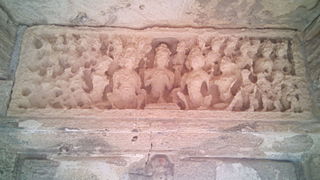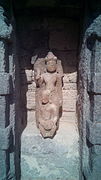
Pattadakal, also called Paṭṭadakallu or Raktapura, is a complex of 7th and 8th century CE Hindu and Jain temples in northern Karnataka (India). Located on the west bank of the Malaprabha River in Bagalakote district, this UNESCO World Heritage site is 14 miles (23 km) from Badami and about 6 miles (9.7 km) from Aihole, both of which are historically significant centres of Chalukya monuments. The monument is a protected site under Indian law and is managed by the Archaeological Survey of India (ASI).

The Maitraka dynasty ruled western India from approximately 475 to approximately 776 CE from their capital at Vallabhi. With the sole exception of Dharapatta, who followed the Mithraic mysteries, they were followers of Shaivism. Their origin is uncertain but they were probably Chandravanshi Kshatriyas.
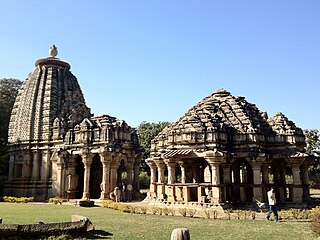
The Baroli Temples Complex, also known as the Badoli temples, is located in Baroli village in Rawatbhata town in Chittorgarh district of Rajasthan, India. The complex of eight temples is situated within a walled enclosure; an additional temple is about 1 kilometre (0.62 mi) away. They are built in the Gurjara Pratihara style of temple architecture dated to the tenth century A.D. All nine temples are under the control of the Archaeological Survey of India for conservation and protection. A well known art critic characterised "the creations of Badoli as the most perfect of their age that he had encountered within that part of the country and, in their own peculiar style."
Jethwa is a branch of the Suryavanshi clan.
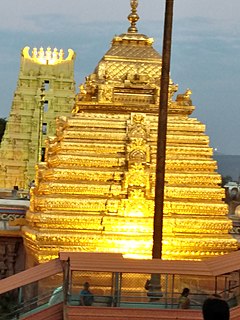
Sri Bhramaramba Mallikarjuna Temple or Srisailam Temple is a Hindu temple dedicated to the deities Shiva and Parvati, located at Srisailam in Indian state of Andhra Pradesh.
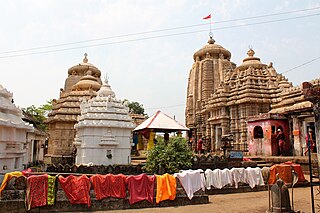
The Kapilesvara temple is a Hindu temple dedicated to Lord Siva located in the south western outskirt of the village Kapilesvara, Old Town, Bhubaneswar, Odisha, India. It is located at the end of Kapilesvara road leading from Lingaraj temple to Kapilesvara Village. The presiding deity is a Siva-lingam at the center of a circular yonipitha inside the sanctum. It is a living temple, facing towards east and maintained by Kapilesvara Temple Trust Board. The temple is situated within the precinct along with 33 other monuments. The precinct is located on the northern embankment of Manikarnika tank over an area of 44.00 square metres.

Navlakha Temple at Ghumli, Gujarat, India, is a 12th Century temple built by Jethwa rulers.

Khambhalida Caves, or Rajkot Caves, are three Buddhist caves located near Gondal in Rajkot district, Gujarat, India.
Pindara, also known as Pindaraka or Pindataraka is a village near Dwarka, on the shoreline of Gulf of Kutch, in Devbhoomi Dwarka district of Gujarat, India.

The Bhojeshwar Temple is an incomplete Hindu temple in Bhojpur village of Madhya Pradesh, India. Dedicated to Shiva, it houses a 7.5 feet (2.3 m) high lingam in its sanctum.

The Gop temple is a Sun temple located at Zinavari village in Jamjodhpur Taluka of Jamnagar district, Gujarat, India. The Hindu temple is dated to the 6th century and is one of the earliest surviving stone temples in Gujarat. The original temple had a square plan, a mandapa and covered circumambulation passage which are lost, and a pyramidal masonry roof which is ruined but whose partial remains have survived. The temple has a height of 23 feet (7.0 m) which includes a small tower. The roof of the tower is decorated with arch-like gavaksha window shapes below an amalaka cogged wheel-shaped crown.
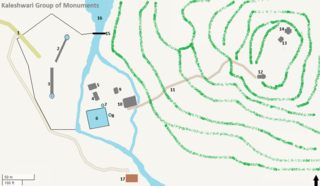
The Kaleshwari Group of Monuments, also known as Kaleshwari-Ni Nal, is located near Lavana village, Khanpur Taluka of Mahisagar district, Gujarat, India. It is near the district headquarters Lunavada and near a stream in Hidimba Van, the forest of Hidimba. The group includes intricately-carved temple ruins, two stepwells, a reservoir, structures with panels of erotic sculptures and idols scattered all over the site. The ruins are located at the foothills and on the hillock. They were built between the 10th and 16th century; some monuments were reconstructed after the 18th century. These are State Protected Monuments.

Firangi Deval, also known as Devalvasi, is an old temple monument located in Kalsar village near Mahuva, Bhavnagar district, Gujarat, India.

The Khed-Roda Group of Monuments include 8th-9th century dated seven Hindu temples built during Gurjara-Pratihara or Rashtrakuta period. It also include a reservoir (Kund) and a stepwell. They are located between Raisingpura (Roda) and Khed Chandarani villages, 18 km from Himmatnagar in Sabarkantha district of Gujarat, India. It is located on the bank of the seasonal stream which merges Hathmati river downstream.
The Saindhavas, also known as Jayadrathas, ruled western Saurashtra from c. 735 CE to c. 920 CE, probably in alliance with Maitrakas in early years. Their capital was at Bhutamabilika. The known historical events during their rule are the attacks of Arabs repulsed by Agguka I.

The Shiva temple is located at Bavka in Dahod district, Gujarat, India. It is located on a knoll near Hirlav lake between Bavka and Chandavada village, 14 km from Dahod.
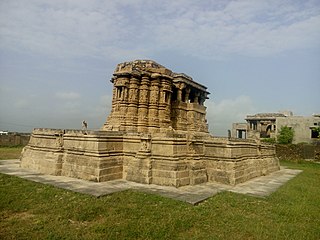
The Rama Lakshamana Temples or Samba Lakshamana Temples are the late 12th century twin Hindu temples in Baradia, a village in Okhamandal region of Devbhoomi Dwarka district, Gujarat, India. Baradia is about five km southeast of Dwarka. There are some temples near the coast within the limits of the village.

Magderu is an 8th-century temple of Maitraka period located near Dhrasanvel village in Okhamandal Taluka of Devbhoomi Dwarka district, Gujarat, India. The temple is located three miles northeast of Dwarka.

The Galteshwar is a Hindu temple dedicated to Shiva, located at Sarnal village near Dakor in Kheda district, Gujarat, India. The 12th century temple is unique in its style and of its period because it is built in central Indian Malwa style, bhumija, without influence of Paramara architecture and with influence of Gujarati Chaulukya architecture. It has a square garbhagriha as well as octagonal mandapa.
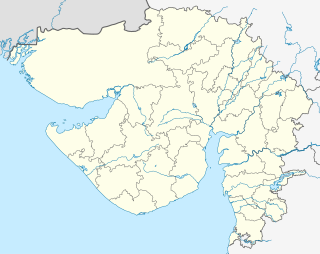
The Kalika Mata Temple is located at New Dhrewad in Devbhoomi Dwarka district, Gujarat, India.





